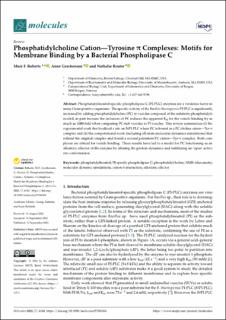Phosphatidylcholine Cation—Tyrosine π Complexes: Motifs for Membrane Binding by a Bacterial Phospholipase C
Journal article, Peer reviewed
Published version

Åpne
Permanent lenke
https://hdl.handle.net/11250/3043940Utgivelsesdato
2022-09-21Metadata
Vis full innførselSamlinger
- Department of Informatics [927]
- Registrations from Cristin [9766]
Sammendrag
Phosphatidylinositol-specific phospholipase C (PI-PLC) enzymes are a virulence factor in many Gram-positive organisms. The specific activity of the Bacillus thuringiensis PI-PLC is significantly increased by adding phosphatidylcholine (PC) to vesicles composed of the substrate phosphatidylinositol, in part because the inclusion of PC reduces the apparent Kd for the vesicle binding by as much as 1000-fold when comparing PC-rich vesicles to PI vesicles. This review summarizes (i) the experimental work that localized a site on BtPI-PLC where PC is bound as a PC choline cation—Tyr-π complex and (ii) the computational work (including all-atom molecular dynamics simulations) that refined the original complex and found a second persistent PC cation—Tyr-π complex. Both complexes are critical for vesicle binding. These results have led to a model for PC functioning as an allosteric effector of the enzyme by altering the protein dynamics and stabilizing an ‘open’ active site conformation.
